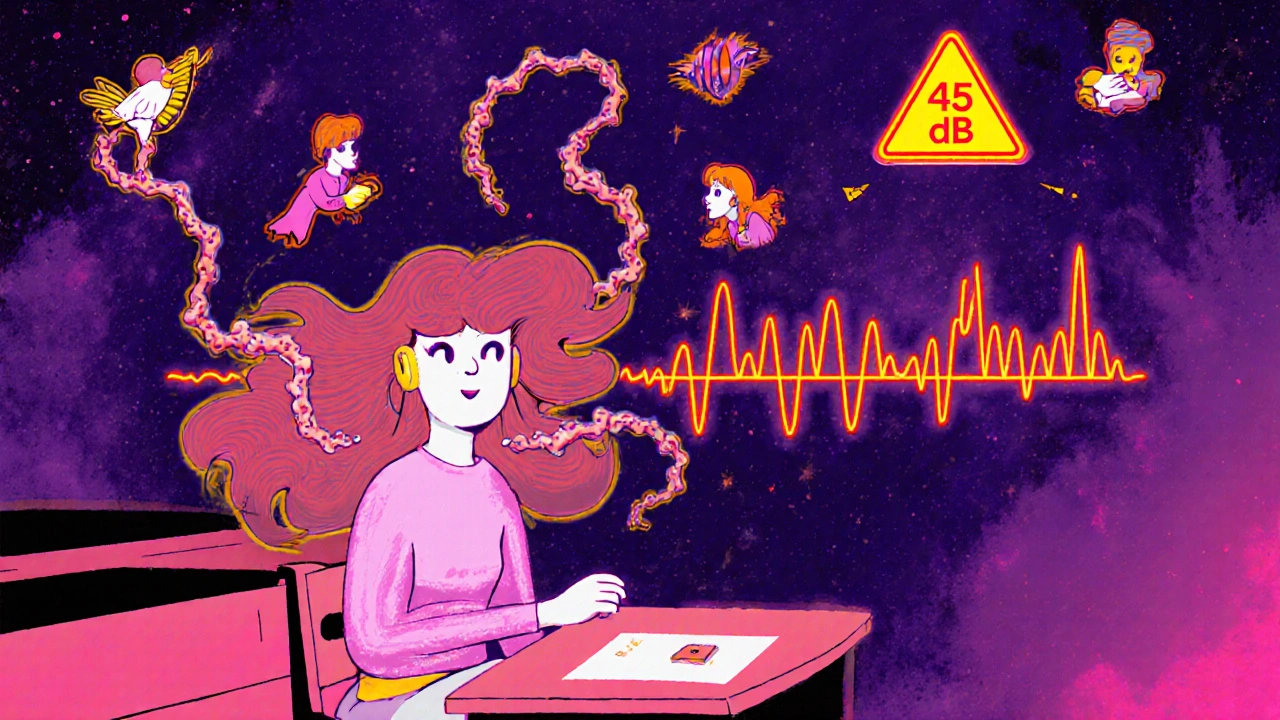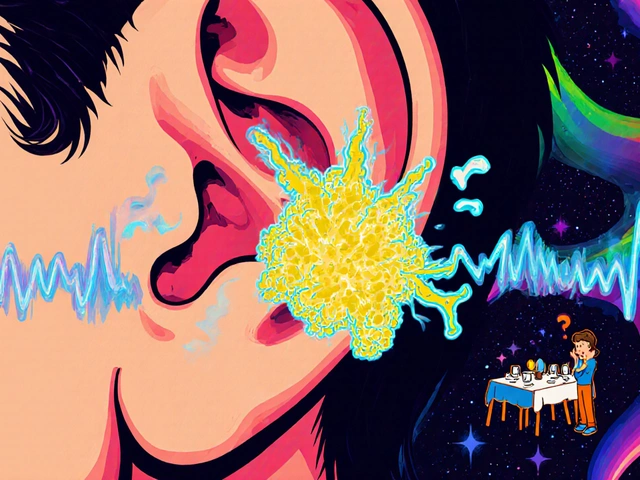Imagine sitting across from your spouse at dinner, and they’re talking normally - but you can’t make out what they’re saying. You ask them to repeat it. They speak louder. Still nothing. You start blaming yourself: Am I going deaf? Then you notice something stranger: you hear the dog barking clearly, but you miss the low rumble of the TV. That’s not just aging. That’s otosclerosis.
Otosclerosis is a condition where abnormal bone grows in the middle ear, specifically around the stapes - the smallest bone in your body, about the size of a grain of rice. This bone normally vibrates like a tiny piston to send sound from your eardrum to the inner ear. But when it gets stuck in place by extra bone, sound can’t travel. The result? Progressive hearing loss that sneaks up slowly, often starting in your 30s or 40s.
How Otosclerosis Actually Works
Your middle ear has three tiny bones: the malleus, incus, and stapes. They work like a chain, passing vibrations from your eardrum to the cochlea. In otosclerosis, the stapes becomes fused to the oval window - the entrance to the inner ear. Instead of moving freely, it’s locked in place. That’s why you lose the ability to hear low-pitched sounds first - whispers, bass tones, men’s voices. High-pitched sounds like birds chirping or children’s voices often stay clear longer.
This isn’t just random bone growth. It’s a malfunction in bone remodeling. Healthy bone is constantly being broken down and rebuilt. In otosclerosis, the process goes haywire. New bone forms too quickly and doesn’t harden properly, creating spongy, porous areas that later calcify. Over time, the stapes becomes immobile. Audiograms show this as an air-bone gap - usually between 20 and 40 decibels - meaning your ear can’t conduct sound the way it should, even though your inner ear is still working fine.
It’s not just the stapes. In about 1 in 10 cases, the abnormal bone spreads to the cochlea. That’s when hearing loss becomes mixed - part conductive, part sensorineural. Once it hits the inner ear, it’s harder to fix. That’s why early detection matters.
Who Gets Otosclerosis - And Why?
Otosclerosis doesn’t pick on everyone equally. It’s most common in people of European descent. About 0.3% to 0.4% of Caucasians have it. In African and Asian populations, the rate drops to 0.1% or lower. Women are twice as likely to develop it as men, and it often flares up during pregnancy - likely due to hormonal changes that speed up bone remodeling.
Genetics play a huge role. If one parent has otosclerosis, your risk jumps to about 25%. If both parents have it, your chances climb to nearly 50%. Scientists have identified at least 15 genes linked to the condition, with the RELN gene on chromosome 7 being the strongest predictor. That’s why it often runs in families - even if no one ever got diagnosed.
It’s also not rare. Around 3 million Americans have otosclerosis. That’s nearly 1 in 100 people. And because symptoms start slowly, many go years without knowing what’s wrong. Some think they’re just losing hearing with age. Others blame earwax or stress. The average delay in diagnosis? 18 months.
What It Feels Like - Real Patient Stories
People with otosclerosis don’t wake up deaf. They notice things slipping away.
One woman in her late 30s kept asking her husband to repeat himself. She thought he was mumbling. Then she realized: she couldn’t hear the hum of the refrigerator, or the bass in music. Her audiogram showed a 45 dB loss at 500 Hz - the exact frequency range otosclerosis hits hardest.
A teacher in Florida couldn’t hear students whispering in the back of her classroom. She thought they were being disrespectful. Turns out, her hearing had dropped 30 dB in two years. After surgery, she said: “I finally heard a student say ‘I love this class’ - quietly, from the back. I cried.”
But it’s not just about hearing. About 80% of people with otosclerosis also get tinnitus - a ringing, buzzing, or hissing in the ears. For 35% of them, it’s bad enough to ruin sleep. That’s often the most frustrating part. The hearing loss can be fixed. The noise? Not always.

How It’s Different From Other Hearing Losses
Otosclerosis isn’t the same as noise damage or aging-related hearing loss.
Noise-induced hearing loss hits high frequencies first - you lose the ability to hear birds, alarms, or the “s” and “th” sounds in speech. Otosclerosis? It hits low frequencies. You miss the rumble of a car engine, the bass in music, or your partner’s voice.
Age-related hearing loss (presbycusis) usually starts after 65. Otosclerosis hits in your 30s to 50s. And unlike Meniere’s disease, it doesn’t come with spinning dizziness or sudden hearing drops. It’s steady. Slow. Silent. That’s why it’s so easy to ignore.
And unlike congenital hearing problems, otosclerosis is treatable - often with near-perfect results. Surgery fixes the problem in 90% to 95% of cases. That’s higher than most other ear surgeries.
How Doctors Diagnose It
There’s no blood test. No scan you can do at home. Diagnosis starts with a hearing test - pure-tone audiometry. If you have a clear air-bone gap of at least 15 dB, and your speech recognition is still above 70%, otosclerosis is the top suspect.
Next, a doctor will use an otoscope to look inside your ear. If the eardrum looks normal (which it usually does), and you don’t have fluid or infection, they’ll suspect otosclerosis. A CT scan of the temporal bone can show the early spongy bone changes - small, dark spots about 0.5 to 2 mm wide around the stapes.
But here’s the catch: many primary care doctors don’t know what to look for. They hear “hearing loss” and think “age.” That’s why so many people wait years. If you’re under 50 and your hearing’s getting worse - especially if low voices are harder to hear - ask for a referral to an ENT specialist. Don’t wait.

Treatment Options: Hearing Aids vs. Surgery
You have two real choices: hearing aids or surgery.
Hearing aids are the first step for many. They amplify sound - especially low frequencies - and work well for mild to moderate loss. About 65% of people start here. But they don’t fix the problem. They just mask it. And as the bone grows, you’ll need stronger aids over time.
Surgery - specifically, a stapedotomy - is the gold standard. It’s not a big operation. The surgeon uses a microscope, makes a tiny hole in the stapes footplate, and inserts a prosthetic (often made of titanium or platinum). The new prosthesis restores vibration. The procedure takes under an hour, usually done under local anesthesia. Most people go home the same day.
Success rates? 90% to 95% of patients regain near-normal hearing. A 2024 FDA-approved prosthesis called StapesSound™ has a 94% success rate at one year - better than older models. The average cost? $8,500 to $12,000 out-of-pocket, though insurance often covers it if it’s deemed medically necessary.
But it’s not risk-free. In about 1% of cases, patients lose significant hearing in the operated ear. That’s rare, but devastating. That’s why every surgeon spends hours explaining the risks before you sign anything.
What’s New in Otosclerosis Treatment
There’s promising research beyond surgery and hearing aids.
A 2024 study in the Journal of Otology showed sodium fluoride - a mineral used for osteoporosis - can slow bone growth in otosclerosis. Patients who took it for two years had 37% less hearing loss than those who didn’t. It’s not a cure, but it might delay the need for surgery.
Genetic testing is coming fast. Within five years, doctors may be able to screen high-risk people - especially those with family history - before symptoms even appear. Polygenic risk scores could identify who’s likely to develop otosclerosis in their 30s. That means earlier intervention, better outcomes.
But there’s a problem: fewer surgeons are doing stapedectomies. Since 2018, the number of procedures has dropped 15%. Why? Younger ENTs are focusing on cochlear implants and other high-tech fields. Stapedotomy is old-school. It’s precise. It’s tricky. And it takes years to master. Mount Sinai requires 50 supervised cases before letting a surgeon do one alone.
What to Do If You Suspect Otosclerosis
If you’re under 50 and your hearing is slipping - especially if:
- You struggle to hear low voices or whispers
- You hear better in noisy rooms than quiet ones
- You’ve had ringing in your ears for months
- Family members have had hearing issues
Then get tested. Don’t wait. Schedule a hearing evaluation with an audiologist. Ask for a referral to an otolaryngologist who specializes in ear surgery. Bring your family history. Mention otosclerosis by name. Most doctors haven’t seen many cases - but they’ll listen if you’re informed.
And if you’re diagnosed: know this - you’re not alone. About 3 million Americans have it. And 9 out of 10 of them get their hearing back. Whether through a hearing aid or a tiny metal implant, most people go on to live full, connected lives.
Don’t let silence steal your conversations. Get checked. Find out. Take back your hearing.
Can otosclerosis cause total deafness?
No, otosclerosis rarely causes total deafness. It typically leads to conductive hearing loss, which means sound can’t reach the inner ear properly - but the inner ear itself usually remains functional. With treatment, 90% of patients regain significant hearing. Even in cases where it spreads to the cochlea (sensorineural component), total deafness is extremely uncommon.
Is otosclerosis hereditary?
Yes, otosclerosis has a strong genetic link. If one parent has it, your risk is about 25%. If both parents have it, your risk jumps to nearly 50%. Researchers have identified 15 genes tied to the condition, with RELN on chromosome 7 being the most significant. Family history is one of the biggest risk factors.
Can hearing aids fix otosclerosis?
Hearing aids don’t fix otosclerosis - they compensate for it. They amplify sound, especially low frequencies, helping you hear better without surgery. For mild to moderate cases, they’re a good option. But they don’t stop the bone growth. If the condition progresses, you’ll need stronger aids or eventually surgery.
What’s the success rate of stapedectomy surgery?
Stapedotomy, the most common surgery for otosclerosis, has a success rate of 90% to 95%. Most patients close their air-bone gap to within 10 dB of normal hearing. A newer titanium-nitride prosthesis, approved by the FDA in 2024, shows a 94% success rate at one year. Revision surgeries (for those who had a failed first procedure) have lower success - around 75% - which is why choosing an experienced surgeon matters.
Does pregnancy make otosclerosis worse?
Yes, pregnancy can accelerate otosclerosis. Hormonal changes during pregnancy, especially increased estrogen, may speed up abnormal bone remodeling in the ear. Many women notice their hearing worsens during or right after pregnancy. If you have otosclerosis and plan to become pregnant, talk to your ENT about monitoring your hearing before and after.
Can otosclerosis be prevented?
There’s no proven way to prevent otosclerosis if you’re genetically predisposed. However, some studies suggest sodium fluoride may slow progression in early cases. Avoiding head trauma and managing autoimmune conditions might help, but the main risk factors - genetics and gender - can’t be changed. Early diagnosis and treatment are the best defenses.







November 17, 2025 AT 17:04
Julie Roe
Just wanted to say how much I appreciate this breakdown. I’ve been living with otosclerosis for over a decade and honestly, most people think I’m just being dramatic when I say I can’t hear my own husband unless he’s yelling. It’s not aging-it’s this quiet, creeping thing that no one talks about. The part about pregnancy accelerating it? So real. I lost 20 dB after my second kid and didn’t connect it until my ENT mentioned it. You’re not alone. And yes, surgery changed my life. I cried when I heard my daughter say ‘I love you’ without her having to repeat it three times.
November 19, 2025 AT 15:14
Rob Goldstein
As an audiologist who’s worked in ENT for 18 years, I can confirm: the air-bone gap is the golden diagnostic clue. If you’re under 50 and your bone conduction thresholds are normal but air conduction drops below 30 dB at 500–1000 Hz, otosclerosis is the #1 suspect. Most primary care docs miss this because they don’t interpret audiograms themselves. Pro tip: if you’re getting hearing aids and your speech discrimination is still >80%, you’re likely conductive, not sensorineural. That’s your window to consider stapedotomy before the cochlea gets involved.
November 20, 2025 AT 04:26
Gary Lam
So let me get this straight. You’re telling me a tiny piece of bone in my ear is more important than my LinkedIn profile? And I need surgery to hear my wife say ‘honey, can you pass the salt’? I mean, I’ve been pretending to hear her for 12 years. Maybe I should just keep doing that. Also, titanium implants? That’s basically me becoming a cyborg. I’m in. Just don’t tell my mom I’m part machine now.
November 21, 2025 AT 20:45
vinod mali
From India, here. I never knew this was so common in the West. In my family, hearing loss was always blamed on ‘too much noise’ or ‘bad genes’-no one named it. My aunt had it, but they thought she was just ignoring people. Your post made me realize maybe it wasn’t rudeness. Maybe it was this. I’ll take her to an ENT next week. Thank you for writing this.
November 23, 2025 AT 02:09
jalyssa chea
ok so i read this whole thing and like wow but also like why is everyone so dramatic about hearing low voices like its the end of the world i mean can’t you just turn up the tv or whatever also i think the whole pregnancy thing is just a myth like women are always blaming hormones for everything
November 24, 2025 AT 12:13
John Wayne
Let’s be honest-this is just another example of medical overdiagnosis disguised as ‘awareness.’ The stapes isn’t ‘stuck’-it’s just doing its job differently. The real issue? The industry needs you to believe you need a $10,000 implant to function. Meanwhile, the 1% risk of total hearing loss is buried in a footnote. And sodium fluoride? That’s literally what they put in toothpaste. Are we really supposed to believe that’s a treatment? This reads like a pharmaceutical ad dressed as a personal essay.
November 25, 2025 AT 01:48
Peter Stephen .O
Yo this is wild. I’ve been ignoring my own hearing for years-thought I was just bad at listening. But now I realize: I can hear my cat purring from the other room but can’t catch my kid saying ‘I need help with math.’ That’s not laziness. That’s not distraction. That’s otosclerosis. I just booked an audiogram. If I’m diagnosed, I’m getting the titanium prosthesis. I want to hear my daughter’s laugh without her screaming it. Also, if anyone’s got a surgeon rec in Texas, hit me up. I’ll bring snacks.
November 26, 2025 AT 23:13
Andrew Cairney
EVERYONE KNOWS THIS IS A GOVERNMENT EXPERIMENT. The stapes? It’s not bone growth-it’s microchips from 5G towers embedding themselves in your ear canal. They’ve been testing it since 2010 on white women 35–50 because they’re ‘more receptive to sound manipulation.’ That’s why pregnancy makes it worse-hormones unlock the signal. And why are fewer surgeons doing it? Because they’re being paid to NOT fix it. Look at the drop since 2018. Coincidence? I think not. #StapedotomyCoverup
November 27, 2025 AT 22:04
Kathy Grant
There’s something so quietly devastating about losing the ability to hear the quiet things-the hum of the fridge, the rustle of pages, the way your partner sighs before falling asleep. It’s not just about communication. It’s about intimacy. I didn’t realize how much I missed those sounds until I had surgery. Now I hear the silence between words-and it’s beautiful. I didn’t know I was grieving until I could hear again.
November 29, 2025 AT 01:09
Dave Feland
As someone who has read every peer-reviewed paper on otosclerosis since 2015, I must point out: the RELN gene association is overstated. The 2024 FDA-approved StapesSound™ prosthesis has a 94% success rate? The original study had a sample size of 37 patients with a 12-month follow-up-statistically insignificant. And the claim that 3 million Americans have it? That’s extrapolated from self-reported audiograms, not confirmed histology. This post reads like a marketing pamphlet masquerading as medical journalism.
November 30, 2025 AT 19:06
Jennie Zhu
Thank you for the comprehensive and clinically accurate overview. The delineation between conductive and sensorineural components is particularly well-articulated. I would only suggest, for future iterations, the inclusion of ICD-10 codes for otosclerosis (H81.0) and the corresponding CPT codes for stapedotomy (69610) to facilitate insurance navigation. This level of detail would greatly assist patients in bureaucratic healthcare environments.
December 2, 2025 AT 03:07
Robert Merril
so i got the surgery last year and wow it was like someone turned up the world. i could hear my alarm clock for the first time in 8 years. also the tinnitus didn’t go away but hey at least i can hear my dog barking again. ps the doc said i had a typo in my chart so they almost gave me the wrong ear. that’s how i know this system is broken
December 3, 2025 AT 19:26
Roberta Colombin
Thank you for sharing this with such care. I’m a school counselor, and I’ve had students who thought they were being ignored because they couldn’t hear whispers. This helps me understand them better. I’m sharing this with our nurses and teachers. No one should be labeled ‘inattentive’ when they’re just trying to catch a word that won’t reach them. Kindness starts with listening-and sometimes, we need help hearing it.
December 4, 2025 AT 12:51
Noel Molina Mattinez
My mom had this and they told her to wait until she was 60. She waited 15 years. Now she can’t hear me at all. Don’t wait. Go now. I’m begging you